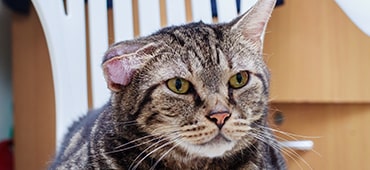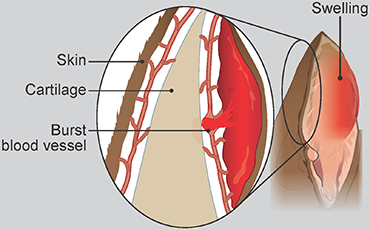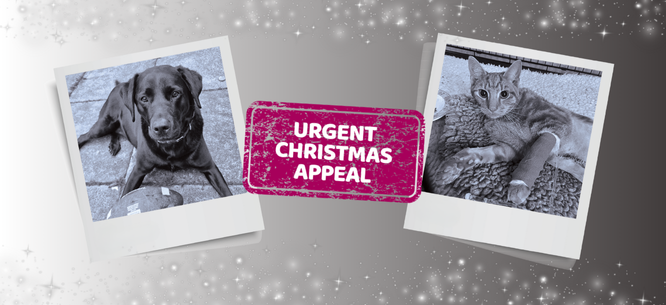Aural Haematoma (swollen ear flap) in cats
Overview
- An aural haematoma is a blood filled swelling in the earflap.
- The swelling is usually soft, hot to touch, and cause the ear to droop depending on its size.
- Most aural haematomas develop because of an underlying problem such as an ear infection, ear mites or skin disease.
- Contact your vet if your cat has an aural haematoma. They will be able to reduce the swelling and treat the underlying cause.
What is an aural haematoma?
An aural haematoma is a pocket full of blood that develops if a blood vessel bursts inside the earflap. Aural haematomas most commonly develop when a cat repeatedly shakes their head or scratches their ear because of an underlying problem such as an ear infection, ear mites or itchy skin. Occasionally aural haematomas form due to a knock or injury, but this is rare.

This cat has a large aural haematoma in his right ear flap
Symptoms of an aural haematoma
As blood fills an earflap and an aural haematoma forms, the ear will suddenly become swollen, hot to touch, droopy, and usually very uncomfortable. Some cats shake their head a lot, and some even develop a head tilt (hold their head to one side).

An aural haematoma is a blood blister in the ear flap.
Treatment
Your cat is likely to need their ear drained, pain relief, and treatment for the underlying cause.
Draining the swelling – some small, painless aural haematomas can be left to heal by themselves, but most are painful and need to be drained. Some can be drained with a syringe and needle, but if the swelling comes back (which is very common even with proper care), your vet may advise surgery to open the earflap, remove the blood, and leave a drainage hole to stop it refilling. If a large aural haematoma is left to heal by itself, it’s likely to cause pain, scarring and eventually, a thickened, crinkly earflap (just like a rugby player with ‘cauliflower ear’). Never try to drain an aural haematoma yourself at home.
Pain relief – aural haematomas are often very uncomfortable so it’s likely that your cat will benefit from pain relief.
Treating the underlying cause – once your vet knows what has caused your cat’s aural haematoma to form in the first place, they will be able to prescribe them treatment. This could be antibiotics for an ear infection, treatment for ear mites, or perhaps anti-itch medication for a skin problem.
Ongoing care and outlook
After your cat has been treated by your vet, you will need to keep their ear clean and protected at home.
- If your cat will tolerate it, try to regularly clean their ear with warm, salty water – be very gentle so not to disturb healing.
- If they are sent home with a head cone you will need to make sure they wear it 24/7 until your vet says otherwise.
- Give them all their prescribed medication – you may find our medication timetable helpful.
- Monitor them for pain, swelling and redness – it’s normal for an aural haematoma to leak a small amount of blood after being drained, but if it bleeds a lot, or for longer than expected, call your vet for advice.
Most cats with an aural haematoma make a full recovery within a week or two (as long as their ear heals without any complications).
Cost
Treatment for an aural haematoma can be expensive, especially if your cat requires surgery.
Consider taking out Cat Insurance as soon as you bring your cat home, before any signs of illness start. This will give you peace of mind that you have some financial support if they ever become unwell.
FAQ's
Can an aural haematoma heal itself?
Some small aural haematoma swellings can heal by themselves, however, there is nearly always an underlying cause that needs treatment (such an ear infection). Ear problems are usually very painful so it’s always best to contact your vet if your cat has developed an aural haematoma.
Can I drain my cat's haematoma?
No, never try to drain your cat’s aural haematoma at home - you could cause further injury or infection.
What causes aural haematoma in cats?
An aural haematoma is caused by a burst blood vessel inside an earflap - usually due to self-trauma because of irritation caused by ear mites, an ear infection or skin disease.
Published: October 2021
Did you find this page useful?
Tell us more
Please note, our vets and nurses are unable to respond to questions via this form. If you are concerned about your pet’s health, please contact your vet directly.
Thank you for your feedback
Want to hear more about PDSA and get pet care tips from our vet experts?
Sign up to our e-newsletter
Written by vets and vet nurses. This advice is for UK pets only. Illustrations by Samantha Elmhurst.

